Today’s stroll Kyoto Kitayama-dori to Kamigamo jinja Shrine
This time, let’s walk from Kitayama-dori, one of the most fashionable main streets in Kyoto, toward Kamigamo jinja Shrine, the oldest shrine in Kyoto. Kitayama Dori is lined with fashionable patisseries and bakeries, and has a slightly different atmosphere from the rest of Kyoto. And from there, you will head toward Kamigamo Shrine, the oldest shrine in Kyoto. From modern times to ancient times. Let’s feel the flow of the times with our feet.
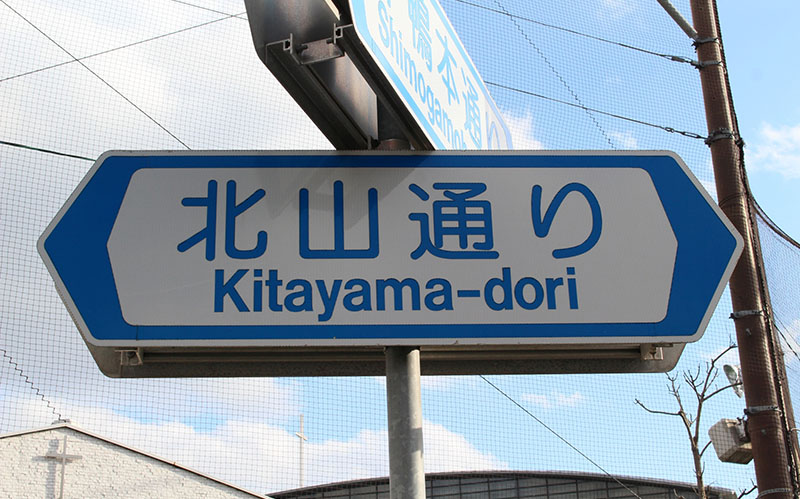
- Today’s Kyoto Stroll Route
- Start strolling toward Kamigamo Shrine, the oldest shrine in Kyoto.
- A.Kitayama Station, Kyoto Municipal Subway
- B. Building designed by Tadao Ando and Garden of Fine Arts Kyoto , where eight different masterpieces can be seen.
- C.Kyoto Botanical Garden, a large site with seasonal plants
- Ota Jinja Shrine, famous for its kakitsubata
- E. Kamigamo Jinja Shrine, one of the oldest shrines in Kyoto
- F. Koryo Museum of Art, which houses Korean & Korean art
- G.Kitayama Station, Kyoto Municipal Subway
- Kyoto Stroll from fashionable Kitayama-dori to Kyoto’s oldest shrine Kamigamo Jinja Shrine Review of walking route
- Kyoto Stroll Kitayama-dori to Kamigamo Jinja Shrine Route Official Website
- Kyoto Stroll Kitayama Street to Kamigamo Shrine Route Recommended Stories Nearby
Today’s Kyoto Stroll Route
A.Kitayama Station, Kyoto Municipal Subway
B. Garden of Fine Arts Kyoto
C.Kyoto Botanical Gardens
D.Ota Jinja Shrine
E. Kamigamo Jinja Shrine
F.Koryo Art Museum
G.Kitayama Station, Kyoto Municipal Subway
Start strolling toward Kamigamo Shrine, the oldest shrine in Kyoto.
A.Kitayama Station, Kyoto Municipal Subway
The Kyoto City Subway Karasuma Line runs through Kyoto City. Kitayama Station, the starting station for this tour, is about 15 minutes away from JR Kyoto Station.
Let’s start our stroll from Kitayama Station on the Kyoto Municipal Subway Line.
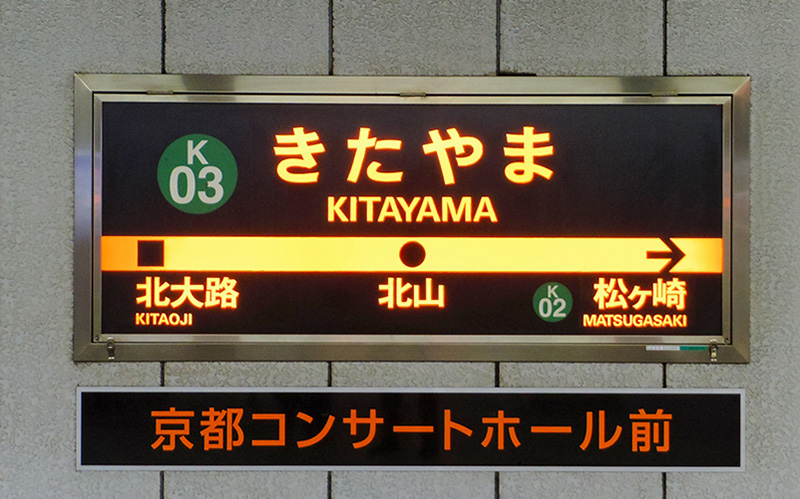
Kitayama Station faces Kitayama-dori, a main street in the north of Kyoto. Kitayama Dori is lined with fashion-related stores as well as patisseries, Western-style restaurants, and bakeries beloved by Kyoto residents. Its atmosphere may be closer to that of Kobe than Kyoto.
Our first destination this time is the “Garden of Fine Arts Kyoto ” located right outside Exit 3 of Kitayama Station. Let’s take a look at it right away.
B. Building designed by Tadao Ando and Garden of Fine Arts Kyoto , where eight different masterpieces can be seen.
Garden of Fine Arts Kyoto is located right next to the Kyoto Botanical Garden, which is a rich natural setting. It is a very small gallery, with only eight works on display. However, it is a place that has a charm not found in other museums.

On display in Garden of Fine Arts Kyoto are full-size Leonardo da Vinci’s “The Last Judgment” and Monet’s “Waterlilies, Morning”. These masterpieces are proudly displayed in the open air.
Normally, paintings are not displayed outdoors. This is because no matter how well they are managed, they are not exempt from deterioration or damage.
However, as the name implies, all the paintings in Garden of Fine Arts Kyoto are precisely reproduced on ceramic boards (ceramic plates). They are virtually unaffected by sunlight, rain, and wind, and can maintain their original beauty for an amazingly long period of time.
Another highlight of Garden of Fine Arts Kyoto is its distinctive architecture.
Although this place is bracketed as a garden, it is not what one would generally imagine. It consists of a beautifully landscaped concrete building by Tadao Ando and water.
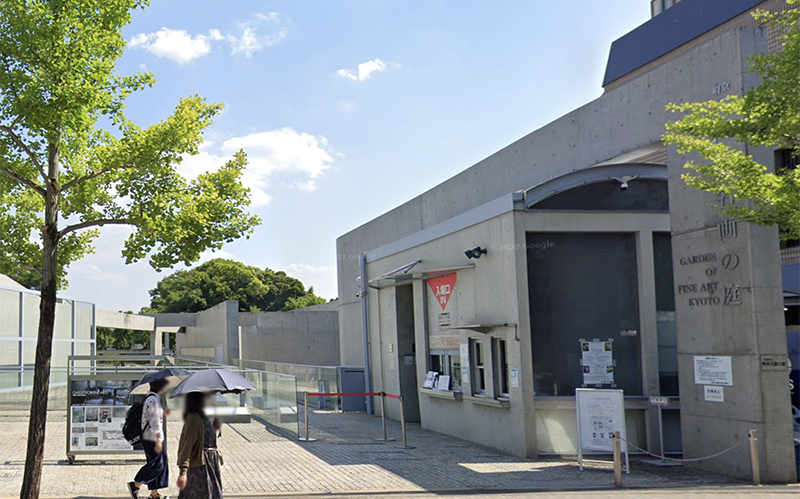
Masterpieces of the past and present are displayed in modern concrete and near water. Although the time required to view them all is short, it will be an intense experience. When you have finished viewing all the masterpieces, proceed to your next destination. That place is the Kyoto Botanical Garden, located right next to Garden of Fine Arts Kyoto .
C.Kyoto Botanical Garden, a large site with seasonal plants
The Kyoto Botanical Garden, located just west of Garden of Fine Arts Kyoto , is said to be the oldest public botanical garden in Japan, having opened in 1924. The garden is home to more than 12,000 varieties of plants that delight the eyes of visitors.
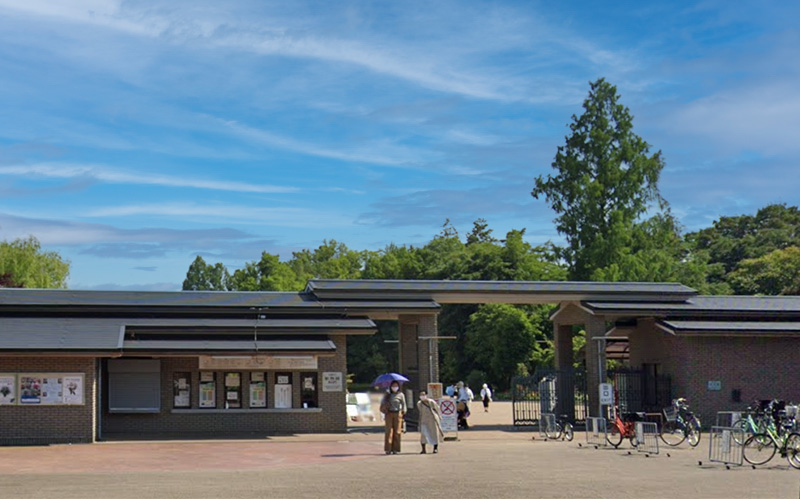
The grounds of the Kyoto Botanical Garden are so vast that it is hard to believe that it is located in Kyoto City. The flower beds located at the main gate on the south side of the botanical garden are filled with flowers of all seasons. If you walk a little west from there, you will find a rose garden and a bed of sun-dried flowers. Let’s take a leisurely stroll through the garden, joining the Kyoto citizens who use the garden for their daily walks.
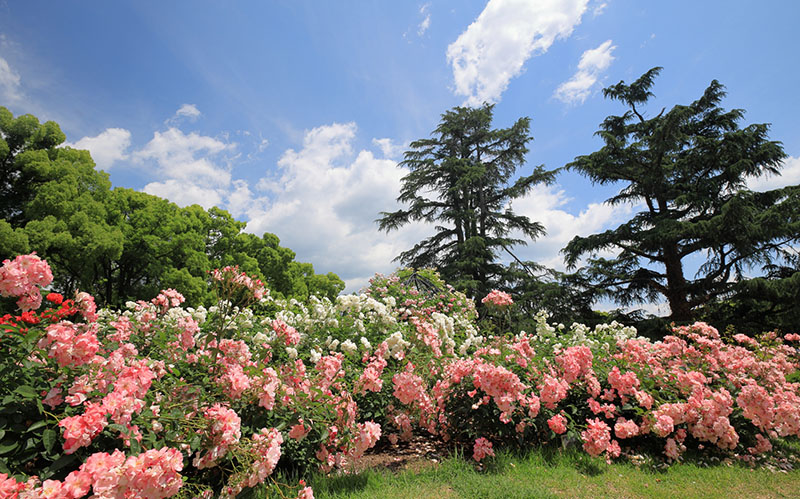

If you have time, a visit to the viewing greenhouse is recommended. (An extra fee is required.) The greenhouse at the Kyoto Botanical Garden is said to be one of the largest in Japan.
The greenhouse at the Kyoto Botanical Garden is said to be one of the largest in Japan. There are 4,500 species of plants on display inside. The greenhouse is divided into a savanna room and a jungle room, and visitors can see rare plants in each of these rooms. In addition, insectivorous plants and orchids are displayed at exhibitions held from time to time.
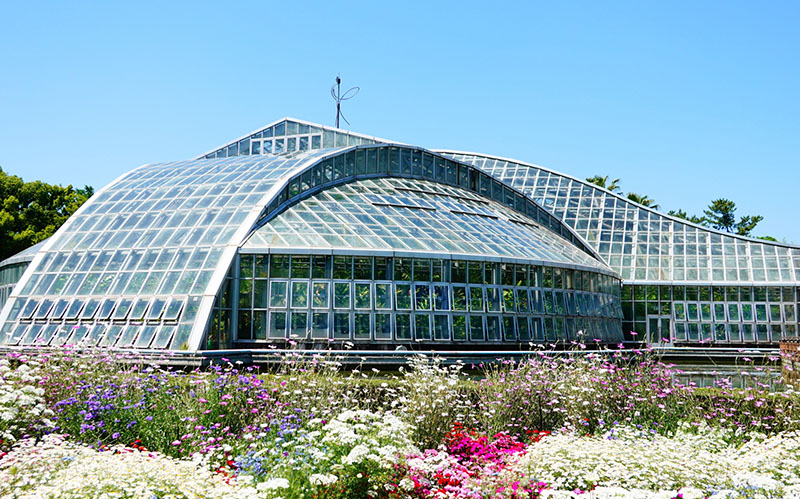
If you are tired from walking through the large park, enter the Great Lawn in the middle of the botanical garden. The lawn is a large expanse of lawn with a café and restrooms. You can sit on the lawn or have a cup of tea at the café. The large enough space allows you to spend your time as you wish without worrying about other people.
After a well-deserved rest, head for the Kamogawa Gate, which is on the north side of the greenhouse. The gate is located on the west side of the gate and allows you to re-enter Kitayama-dori.
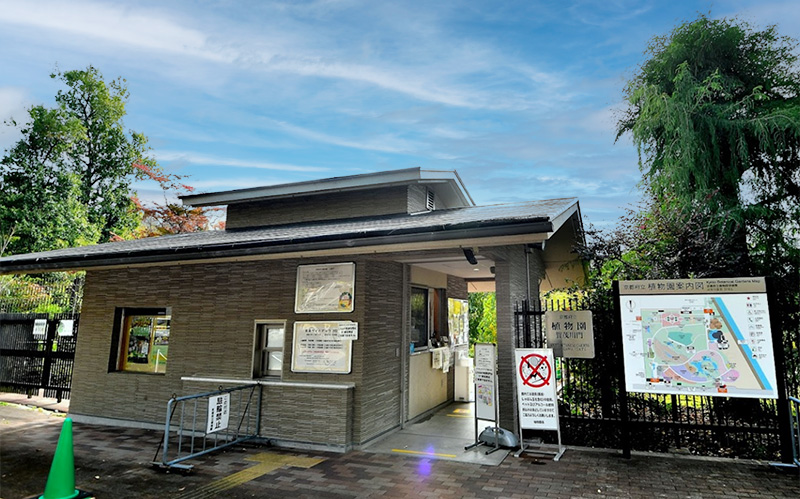
Exit Kitayama Dori and go a little west. Head north at the first traffic light. Continue to walk north through the residential area. After passing the Family Mart convenience store, go west on the next street, and continue north on the second street. Continue to the end of the street, and you will come to your next destination, Ota Jinja Shrine.
Ota Jinja Shrine, famous for its kakitsubata
Ota Jinja Shrine is one of the shrines with the longest history in Kyoto. It is considered to be a branch of KamigamoJinja Shrine, the oldest shrine in Kyoto, which will be introduced later.

The deity of Ota Jinja Shrine is Amenowuzume-no-mikoto. She is the deity who danced in front of Iwato when Amaterasu hid behind it, and is said to be in charge of the performing arts. For this reason, Ota Jinja Shrine is also believed to bring blessings for the improvement of the arts and prolongation of life.
If you visit Ota Jinja Shrine, you should also see the kakitsubata. This place has been famous for its kakitsubata since the Heian period (794-1192), and you can see them growing in clusters. There are as many as 25,000 kakitsubata plants.
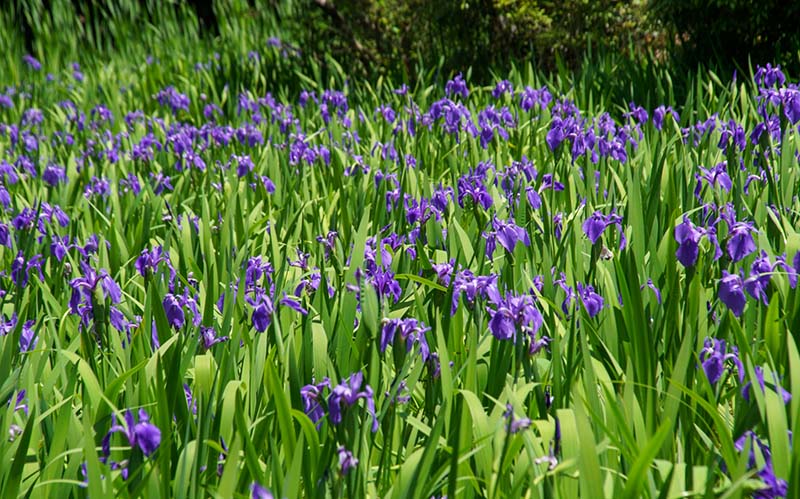
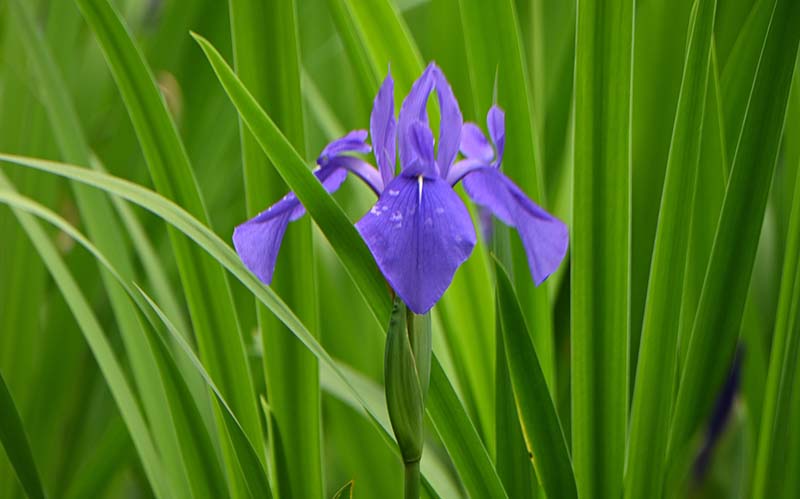
Ota Jinja Shrine itself is a relatively small shrine. After visiting the shrine and making a round of the shrine grounds, head to your next destination.
Leave Ota Jinja Shrine and head straight south. Go back the way you came. At the traffic light marked “Ota-jinja-mae,” head west through a quiet residential area. After a short distance, you should see a large camphor tree on your left. From here on, you will be walking along a beautiful riverside path, typical of the ancient capital.
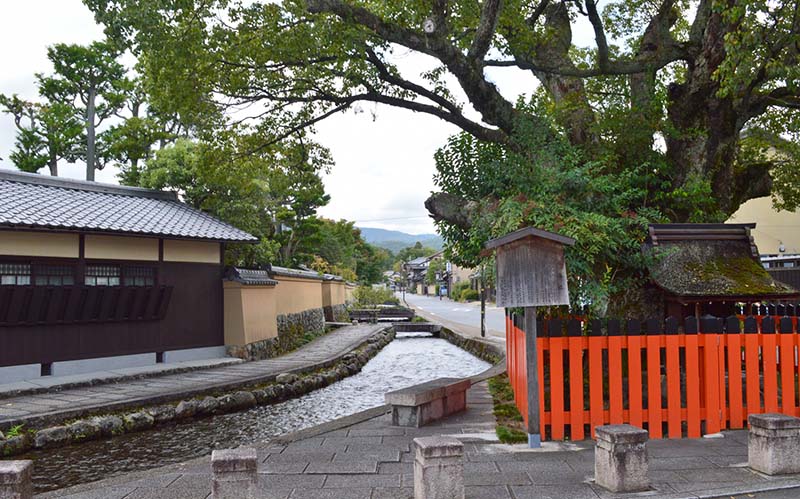
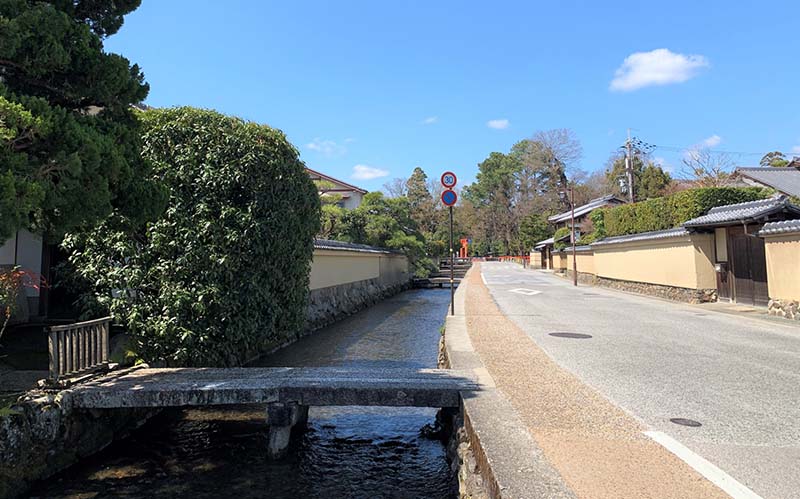
The streets in this area are wonderful, as are the magnificent houses that line them. It is not a crowded tourist area, but it is worth a visit. Continue straight ahead and you will see a large red torii gate. This is the Otorii of Kamigamo Jinja Shrine, our destination.
E. Kamigamo Jinja Shrine, one of the oldest shrines in Kyoto
Kamigamo Jinja Shrine is one of the oldest shrines in Kyoto. Its official name is Kamowakeikazuchi Jinja Shrine. Its construction dates back to 678 during the Asuka Period.
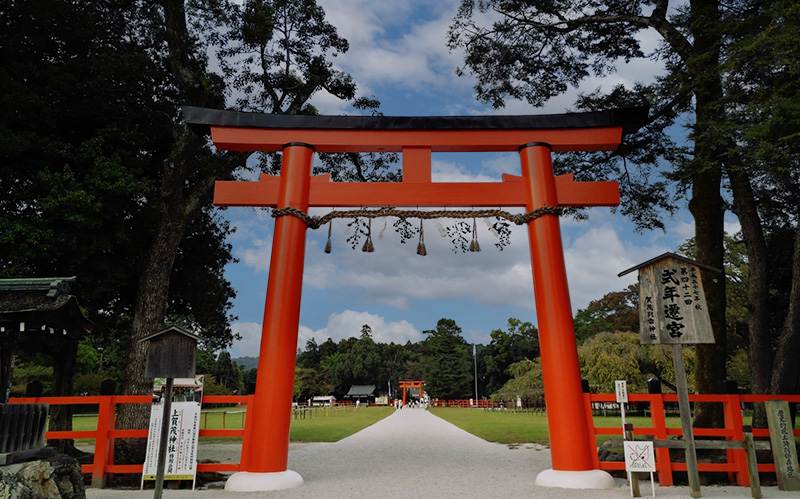
The main deity of Kamigamo Jinja Shrine is Kamo Betsurai-no-mikoto. It is said to be the clan deity of the Kamo clan, which ruled the whole Kamigamo region, and has been worshipped here since ancient times. Together with ShimogamoJinja Shrine (official name: Kamo Goso-jinja), located a little further south, it is also called Kamo Jinja Shrine.
The highlights of Kamigamo Jinja Shrine are the beautifully shining tower gate and the main shrine. The tower gate is designated as an Important Cultural Property and is beautifully painted in vermilion. The main hall is also designated as a National Treasure and features paintings by the Kano school of artists. However, the main hall can only be viewed during special visits, which cost around 1,000 yen, so those interested are encouraged to enter.

There is also a river called “Narano creek” running through the precincts of the temple. It is a beautiful stream surrounded by trees, and it is possible to stroll along the path beside it. Take a stroll and enjoy the peace and tranquility.
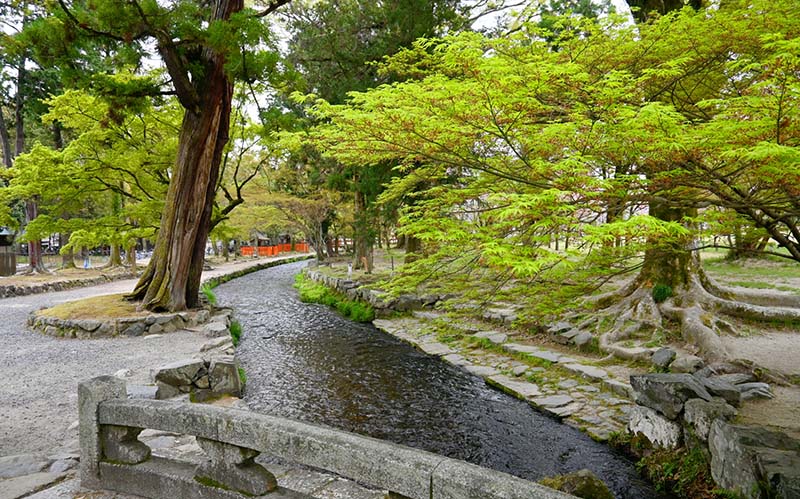
When you have finished exploring the grounds of Kamigamo Jinja Shrine, walk to your final destination.
As you exit the Otorii gate of Kamigamo Jinja Shrine, you will see a roundabout. Go through that roundabout to the west. You will soon see a large bridge called “Misonobashi.
After crossing the Misono Bridge, walk along the river to the south. After a short walk, you will come to a Y-shaped intersection. Turn left at the intersection and continue walking. Keep going and turn west at the next set of traffic lights, and you will see the “Koryo Museum of Art,” a building with a strange stone structure guarding its gate, on your immediate right.
F. Koryo Museum of Art, which houses Korean & Korean art
The Koryo Art Museum is the only museum in Japan that specializes in Korean and Korean antiques. Although it is a small museum, visitors can see intangibles that cannot be found anywhere else, such as the beautifully white “Joseon white porcelain vase.
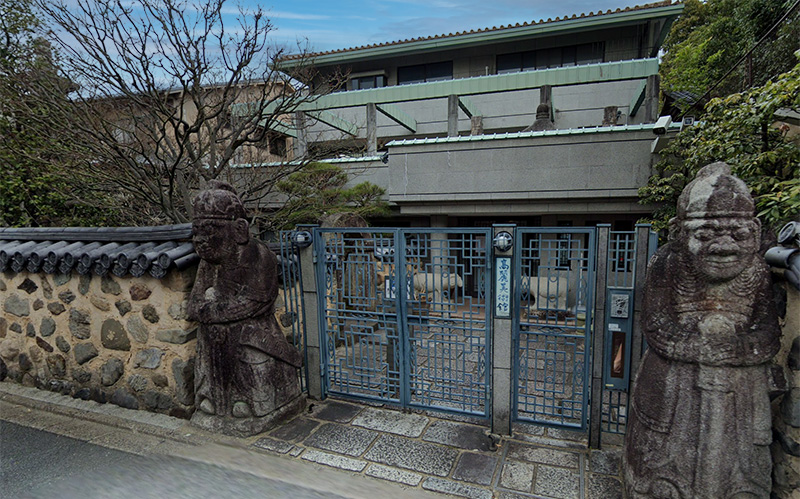
The Koryo Museum of Art is characterized by its frequent special exhibitions. Special exhibitions are held on various themes, allowing visitors to experience Korean and Korean history from a unique perspective. In addition, many stone structures are placed in the garden, and it is fun to take pictures with them.
In addition, the Koryo Museum of Art sometimes holds gallery talks by curators. If you are lucky enough to find a date and time, be sure to attend. You will be able to learn anecdotes about the antique artworks that are usually difficult to find out.
Once you have fully appreciated the Koryo Art Museum, it is time to end your walk. Exit through the gate and head for Beisan Station.
G.Kitayama Station, Kyoto Municipal Subway
Exit the Koryo Museum of Art and head east, down the main street to the south. After walking along the main street for a while, you will see a traffic light. Turn east at the traffic light and take Kamo Kaido along the river.
Kamo Kaido is a busy street. It is not suitable for walking straight ahead. There is a place to go down to the bank of the river, so walk along the bank from there.

The bank of the Kamo River is a place where children, dog walkers, and people exercising to their heart’s content spend their time. Let’s mingle among them and head toward the station in a relaxed manner. If the time of year is right, you can even see cherry blossoms in full bloom.
Keep walking and you will see the large “Kitayama Bridge. Go up from the bank, walk east, and cross the bridge. After crossing the bridge, you will see the botanical garden to the south, and beyond that you will find the entrance to Kitayama Station.
Thank you again for your hard work today.
Kyoto Stroll from fashionable Kitayama-dori to Kyoto’s oldest shrine Kamigamo Jinja Shrine Review of walking route
A. (Start) Kitayama Station, Kyoto Municipal Subway
↓ 120m
B. Garden of Fine Arts Kyoto
↓ 90m
C. Kyoto Botanical Garden
↓ 1.1km
D. Ota Jinja Shrine
↓ 950m
E. Kamigamo Jinja Shrine
↓ 600m
F. Koryo Art Museum
↓ 1.7km
G. (Goal) Kitayama Station, Kyoto Municipal Subway
Kyoto Stroll Kitayama-dori to Kamigamo Jinja Shrine Route Official Website
Garden of Fine Arts Kyoto Official website Click here
Kyoto Botanical Garden Official website Click here
Ota Jinja Shrine Official website Click here
Kamigamo Jinja Shrine Official website Click here
Koryo Art Museum Official website Click here
